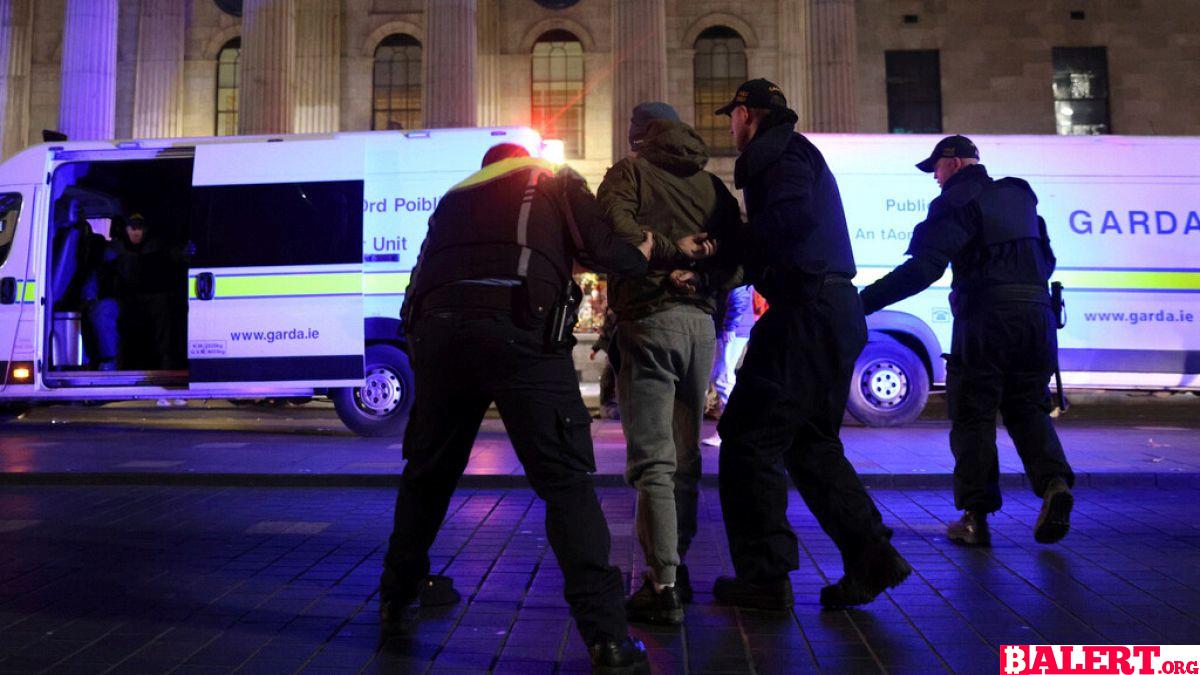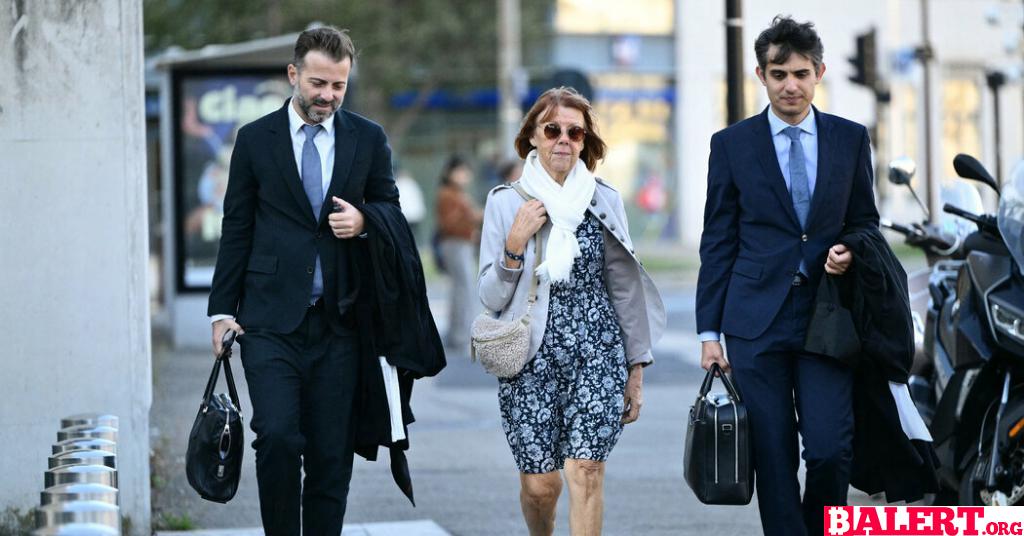World
The Evolving Political Dynamics of Ireland: Sinn Féin’s Challenges and the Rise of Far-Right Sentiments
Explore the shifting political landscape of Ireland as Sinn Féin navigates its challenges amidst the troubling rise of far-right sentiments. Discover the implications for democracy and social cohesion in this insightful analysis.

The Shifting Political Landscape in Ireland

Until recently, Ireland was bracing itself for a potential political upheaval that could reshape its governance for generations: a government led by the nationalist party Sinn Féin. However, what once seemed to be a foregone conclusion has now turned into an uncertain reality. Rather than dominating the political scene, Sinn Féin finds itself adapting to a rapidly changing environment.
Historically recognized as the political arm of the Provisional Irish Republican Army during the Troubles, Sinn Féin has managed to reinvent itself as a mainstream political force. It has adopted a distinctly leftist and populist stance, which contrasts sharply with the prevailing ideologies of Irish politics.
In the 2020 general election, Sinn Féin secured nearly a quarter of the national vote, outpacing both of the traditional powerhouses, Fianna Fáil and Fine Gael. Following this electoral success, opinion polls frequently indicated that Sinn Féin might be positioned to form a coalition government after the next national elections. Yet, in June of this year, the party’s performance in the European elections, alongside local elections, fell significantly short of expectations, dampening the once widely held belief that it would be leading the government by next year.
In a twist of irony, this decline occurred shortly after Sinn Féin enjoyed a strong showing in Northern Ireland during the British general election on July 4. There, Irish nationalist parties outperformed those advocating for the north’s continued status as part of the UK. Currently, Sinn Féin stands as the largest party in the Northern Irish Assembly, with its regional leader, Michelle O’Neill, making history as the first Irish nationalist to hold the position of First Minister. However, the party’s struggles in the Republic of Ireland, where it seeks to fully unite the island under one state, will undoubtedly be a source of disappointment.
The situation is compounded by emerging signs that Sinn Féin is losing traction with the very communities that have historically formed its base among working-class populations in Ireland’s urban areas.
Revolt on the Right
As a new generation emerges that does not associate Sinn Féin with the violent legacy of the past, the party has begun to attract support from educated, left-leaning, and more affluent young voters. These individuals resonate with Sinn Féin’s progressive stances on critical issues such as climate change, foreign policy (notably regarding the Israel-Palestine conflict), and LGBTQ+ rights. However, while trying to court this demographic, Sinn Féin faces challenges in appealing to its traditional voter base, who are grappling with a severe housing crisis—an issue that has become a defining aspect of Irish politics and has opened avenues for a burgeoning far-right movement.
Although far-right activists have been organizing in Ireland for some time, several extreme and anti-immigration parties have yet to unify under a common banner. Nevertheless, 2023 marked a pivotal moment as these groups successfully capitalized on existing discontent surrounding the perceived strains on society resulting from large-scale immigration, particularly the influx of Ukrainian refugees—approximately 80,000 since the onset of Russia’s full-scale invasion in 2022—as well as asylum seekers from various countries.
While most new arrivals have been welcomed without significant incident, the politics surrounding their accommodation remains complex. The crux of the issue lies in Ireland’s chronic housing shortage, a problem rooted in the financial crisis of 2008 and subsequent years of underinvestment in housing development. The scale of this crisis is staggering: with a population of 5 million, the government’s Housing Commission estimates a shortfall of up to 250,000 homes.
Since the end of COVID-19 restrictions, evictions from private rental properties have surged, and rents have skyrocketed. The government has pledged to build more than 30,000 homes annually to address the housing crisis. However, many Irish families continue to find themselves in temporary accommodations while the housing supply struggles to keep pace with the growing number of new arrivals.
Out in the Streets
In this climate, far-right activists have exploited the housing crisis to incite not only discontent but also violence. A particularly shocking incident occurred in Dublin last November when a man stabbed several individuals, including children, outside a primary school. The alleged assailant, a homeless man of Algerian descent who had lived in Ireland for two decades, triggered violent protests and looting, resulting in around 40 arrests. Many attributed the turmoil to incitement and misinformation spread by far-right influencers, as evidenced by the racist and anti-immigrant chants that echoed during the chaos.
However, this riot was not an isolated event. In March of the same year, a camp housing unhoused migrants in Dublin was attacked and burned down, an act that far-right groups celebrated as a “total Gaelic victory.” Following these violent outbreaks, police have attempted to deter asylum seekers and immigrants from sleeping rough in the city by conducting early morning sweeps, only for new encampments to emerge shortly afterward.
Protests against migrant reception centers and accommodations for asylum seekers have become increasingly common, fueled by right-wing activists and influencers. One of the most notable incidents occurred in Coolock, North Dublin, where a demonstration against a proposed migrant housing center spiraled into clashes with police and resulted in a former factory being set ablaze. The protest was organized by a group identifying as “Coolock Says No,” a slogan adapted by online activists to frame similar unrest in other areas.
‘None of Us Have a Veto’
For Sinn Féin, navigating the rising anger over large-scale refugee arrivals presents a formidable challenge. The right-wing agitators who amplify small protests on social media often intertwine issues of social class and Irish racial identity, merging a long-standing nationalist narrative of working-class uprisings with more overtly racist and ethnonationalist rhetoric, which directly contradicts the liberal social values Sinn Féin has embraced in recent years.
In social media circles rife with these tensions, hashtags such as #IrelandIsFull are being supplanted by ones like #IrelandForTheIrish. Protests against asylum reception centers and housing initiatives are being framed by journalists from lesser-known far-right outlets as part of a burgeoning uprising against the government. Moreover, news stories involving violence or criminal acts by foreigners—especially those of color or Muslim faith—are rapidly circulated, further inflaming sentiments.
The challenge for Sinn Féin lies in balancing their role as the opposition party critiquing government policies, while simultaneously rejecting the knee-jerk, racist backlash against asylum seekers and immigrants. They must also acknowledge that some voters they need are increasingly engaging in what appears to be a social movement, albeit one lacking a unified electoral representation at this stage.
This balancing act was evident during a recent press conference when party leader Mary Lou McDonald was queried by a right-wing journalist about why she did not support giving communities a veto over proposed asylum centers. “I really don’t think it’s helpful for us to get lost in the veto area,” she responded. “What people are looking for is dialogue. They’re also looking for clear information… clarity of information, dialogue, to be listened to. You have your voice, you have to be heard; none of us have a veto. None of us have a veto. That’s not how democratic processes of decision-making and planning work.”
Despite the palpable tension in that exchange, it appears that while the overt anti-asylum and anti-immigration sentiment has made some inroads in local politics, it still lacks a significant foothold at the national parliamentary level. This stands in sharp contrast to other European nations like the UK, France, and Germany, where heavily anti-immigration parties command substantial portions of the national vote without gaining access to governmental power.
On the judicial front, attempts to block accommodations for asylum seekers have not yet gained traction. Recently, a judge dismissed a case aimed at preventing applicants from being housed in a hotel in Dundrum, County Tipperary, which had previously served as temporary housing for Ukrainian refugees. The judge expressed skepticism towards claims that “International Protection Applicants are more likely to be burglars than those staying as guests at the hotel or Ukrainian refugees staying there,” asserting, “I lend no weight to that assertion.”
Furthermore, the High Court in Dublin ruled that the Irish government has violated the EU Charter of Fundamental Rights by failing to provide adequate shelter and basic necessities to asylum seekers, many of whom remain homeless due to a lack of available accommodations.
These rulings are unlikely to quell the growing tensions. Clashes between police and irate residents in various communities are receiving increased coverage in mainstream media, while an online ecosystem of right-wing Irish outlets and influencers continues to expand its audience. All the while, Sinn Féin, which not long ago appeared poised to take the reins of government, grapples with the reality that the socially liberal segment of the younger generation may not suffice to secure their position at the forefront of Irish politics. Furthermore, they face the risk of losing significant portions of their traditional working-class voter base just as they seemed on the verge of achieving power.
World
Dominique Pelicot Testifies in Harrowing Rape Trial
Join us as Dominique Pelicot courageously testifies in a harrowing rape trial, shedding light on the complexities of trauma and justice. Her powerful story raises crucial questions about the legal system and the importance of support for survivors.

Dominique Pelicot Takes the Stand in Shocking Rape Trial
In a courtroom drama that has captivated France and garnered international attention, Dominique Pelicot, the man at the center of a harrowing rape trial, finally addressed the court. With tears streaming down his face, he recounted how his wife had been instrumental in helping him cope with a tumultuous past marked by trauma. He revealed that he had endured a sexual assault at the tender age of nine while hospitalized, and he also witnessed a gang rape during his teenage years while working as an apprentice electrician on a construction site.
“She didn’t deserve this, I acknowledge that,” Mr. Pelicot stated, his voice barely audible as he struggled to convey his emotions. The gravity of the situation weighed heavily on him, and the courtroom fell silent, straining to catch his every word.
Now 71 years old, Mr. Pelicot faces serious allegations of drugging his wife, Gisèle Pelicot, whom he has been married to for half a century, over a span of nearly ten years. Prosecutors contend that he used drugs to render her comatose, allowing him to rape her repeatedly. Furthermore, authorities allege that he went so far as to invite numerous men into their home, facilitating a nightmarish scenario where they, too, engaged in the assault of his wife.
Overall, 51 men, including Mr. Pelicot, are on trial concurrently, primarily facing charges related to the aggravated rape of Ms. Pelicot. Among them, one individual has already pleaded guilty to similar crimes, admitting to drugging his own wife to assault her and inviting Mr. Pelicot to partake in the horrific act while she was incapacitated.
Mr. Pelicot’s unexpected testimony came after a tumultuous start to the trial. Just a week in, he was stricken with severe health issues that forced him to miss four consecutive days in court. The head judge ultimately decided to postpone proceedings, as Mr. Pelicot was diagnosed with kidney stones, a kidney infection, and prostate complications, adding yet another layer of complexity to this already harrowing case.
World
Meta Bans Russian State Media Outlets from Social Media Platforms
Explore the implications of Meta’s decision to ban Russian state media outlets from its social media platforms. Understand the impact on information dissemination and the ongoing battle against misinformation in the digital landscape.

Meta Imposes Global Ban on Russian State Media Outlets
In a significant move, Meta Platforms, Inc., the parent company of Facebook, has announced the prohibition of Russian state media outlets, including RT (Russia Today) and Rossiya Segodnya, from all its social media platforms. The decision stems from the company’s concerns regarding the deceptive strategies employed by these media organizations to execute covert influence operations across the internet.
Meta made this announcement on Monday, emphasizing that the ban will be enforced worldwide across its various platforms, such as Instagram, WhatsApp, and Threads. The rollout of this ban is expected to take place over the coming days.
Statement from Meta
A spokesperson for Meta elaborated on the decision, stating, “After careful consideration, we have expanded our ongoing enforcement actions against Russian state media outlets. As a result, Rossiya Segodnya, RT, and other affiliated entities are now banned from our applications globally due to their involvement in foreign interference activities.”
For further insights into this development, watch the video in the player above.
World
Trump Recalls Alleged Assassination Attempt While Golfing
Explore Donald Trump’s chilling recollection of an alleged assassination attempt he experienced while enjoying a round of golf. Delve into the tense moments and his reflections on safety, fame, and the unpredictability of public life.

In a recent interview on the social media platform X, Republican presidential nominee Donald Trump recounted a harrowing incident he claims to have experienced while playing golf. Trump described how, during a peaceful Sunday morning round with friends, the tranquility of the day was abruptly shattered by the sound of gunfire in the air.
“It was a beautiful day, everything was just perfect,” Trump reflected. “Then all of a sudden, we heard shots being fired—probably around four or five in total.” He went on to explain that a Secret Service agent was the first to spot the suspect, who was allegedly armed with an AK-47, a powerful assault rifle.
“The agent saw the barrel of the weapon and immediately took action, returning fire at the barrel and aiming in the direction of the bushes,” Trump detailed. “I would have loved to have sunk that last putt, but we decided it was best to leave the scene promptly.”
Trump expressed his gratitude towards the agents and a vigilant civilian who aided in tracking down the suspect, who was eventually apprehended following a high-speed chase.
Suspect Faces Multiple Federal Gun Charges
The FBI has identified the suspect as Ryan Wesley Routh, accusing him of targeting Trump during his time at the golf club in West Palm Beach, Florida. According to an FBI report, Routh had allegedly hidden among the hedges of the golf course for an astonishing 12 hours. Authorities discovered an SKS-style assault rifle, a GoPro camera, and a bag of food at the scene.
The 58-year-old Routh is now facing two serious federal gun charges. If convicted on both counts, he could face a combined maximum sentence of 20 years in prison. Notably, neither of the charges is directly related to an assassination attempt. The first charge pertains to possessing a firearm despite a prior felony conviction, which carries a potential 15-year sentence, a fine of $250,000 (€225,000), and three years of supervised release.
The second charge involves possession of a firearm with an obliterated serial number, which could result in a five-year prison term, the same financial penalties, and also three years of supervised release. As the investigation continues, additional charges could be forthcoming.
While the motive behind Routh’s actions remains unclear, his digital footprint reveals strong political affiliations, particularly concerning issues surrounding Ukraine and China. Routh consistently expressed support for Ukraine across various social media platforms, even claiming to have orchestrated a recruitment scheme for international volunteers aiming to assist Ukraine in its fight against Russia’s invasion. This behavior has been denounced by Ukrainian soldiers and members of the International Legion, who disavowed Routh’s actions and motives.
-

 Business5 months ago
Business5 months agoThe Significance of Jackson Hole: A Central Banking Tradition
-

 Tech5 months ago
Tech5 months agoNew Leaks and Features About the Samsung Galaxy S25 Ultra
-

 Business7 months ago
Business7 months agoObituary: Dan Collins
-

 Article7 months ago
Article7 months agoCreative Design Applications Developed with Artificial Intelligence
-

 Business5 months ago
Business5 months agoBhutan’s Strategic Investment in Bitcoin: A New Era for the Himalayan Kingdom
-

 World5 months ago
World5 months agoThierry Breton Resigns: Impact on European Union Leadership
-

 Gaming5 months ago
Gaming5 months agoNew Details and Trailer Released for Dead Rising Deluxe Remaster
-

 Gaming5 months ago
Gaming5 months agoNew Details for Alan Wake 2 and PlayStation 5 Pro Announcement












